David's Astronomy - Nearby Stars (original) (raw)
| David's Astronomy Pages (Projects) Nearby Stars |  AXPStars | |
AXPStars | |  Projects | |
Projects | |  HomePage | |
HomePage | |  ExtraSolarPlanet Sols | |
| ----------------------------------------------- | --------------------------------------------------------------------------------------------- | | ------------------------------------------------------------------------------------ | | ----------------------------------------------------------------------------------- | | ------------------------------------------------------------------------------------------------------------------- | |
ExtraSolarPlanet Sols | |
| ----------------------------------------------- | --------------------------------------------------------------------------------------------- | | ------------------------------------------------------------------------------------ | | ----------------------------------------------------------------------------------- | | ------------------------------------------------------------------------------------------------------------------- | |
Barnard's Star (HIP 87937) - 5.94 ly
| Barnard's Star, HIP 87937 (Ophiuchus) 2nd closest known star system to the Sun only 5.94 light years awayStar with largest known proper motion |
|---|
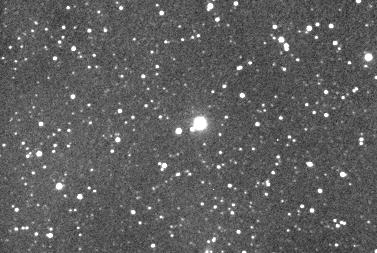 |
| CCD Image (Mag Limit +15)5 x 60s (median combine), clear filter2006-05-06 01:33 h UT (#122231-35) |
| **Motion of Barnard's Star ( 2005-09-30 to 2007-07-23 )**Measured Proper Motion 10.57 arc sec/year, PA 356.28 deg(based on 3 observation pairs separated by one year) [ cf. Hipparcos Value 10.358"/yr, 355.6 ] |
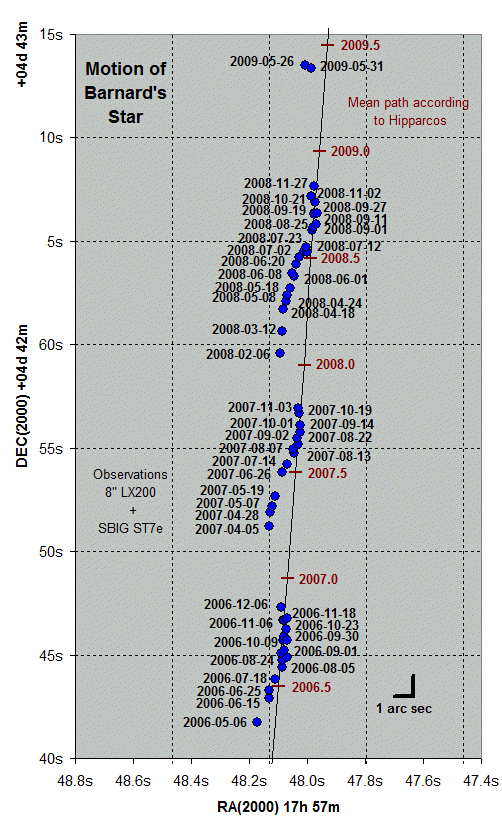 |
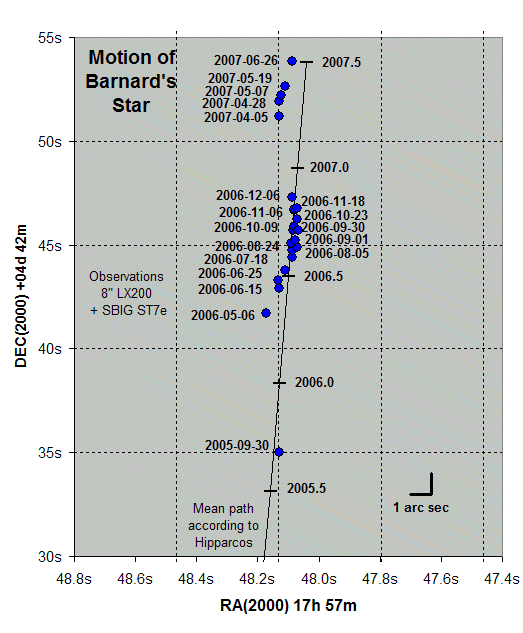 |
| Astrometric measurement of control star shows that it is stationary during the observation period which confirms that Barnard's Star motion is 'real' |
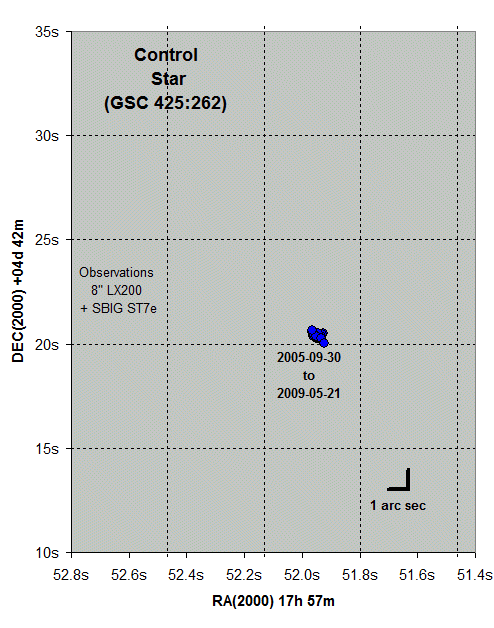 |
| Parallax Estimate for Barnard's Star |
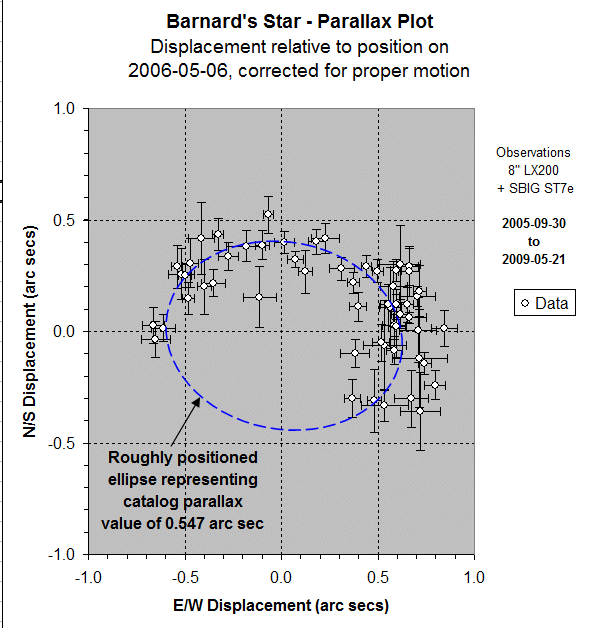 |
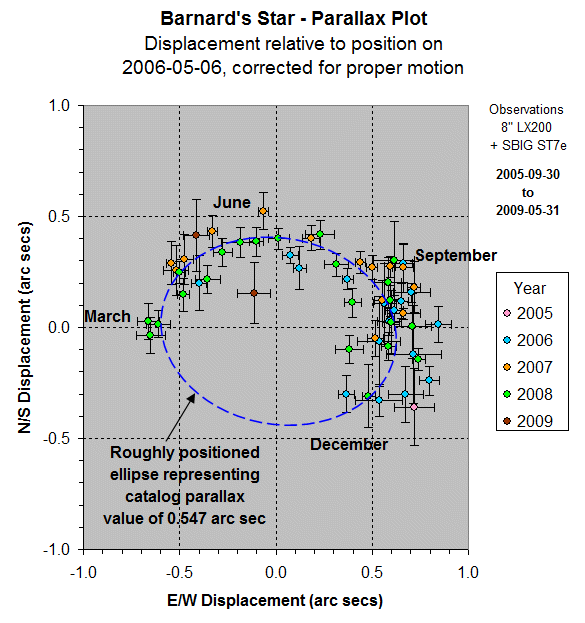 |
| Animation of Images taken one year apart, showing 10 arc sec motion of Barnard's Star |
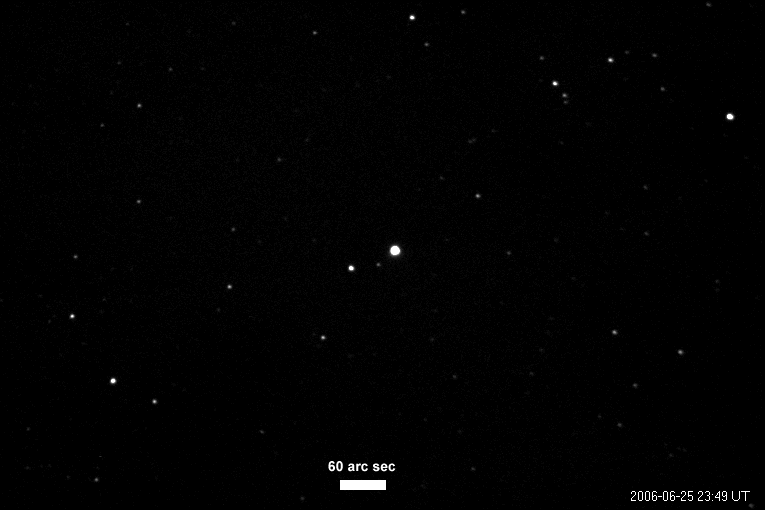 |
| Animated CCD Image a) 2007-06-26 23:07 h UT (#201012-18), 7 x 10s (average combine), C Filterb) 2006-06-25 23:49 h UT (#129162-68), 7 x 10s (average combine), C Filter |
| Comparison of Barnard Star position at 2005-09-30 & 2006-05-06 (7.25 month period) |
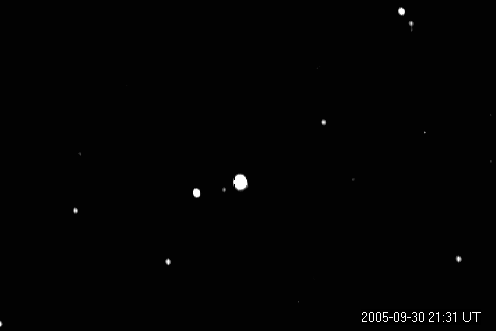 |
| Animated CCD Images2005-09-30 : 20s, 2x2 binning, C Filter (#95034)2006-05-06 : 10s, 1x1 binning, C Filter (#122252) |
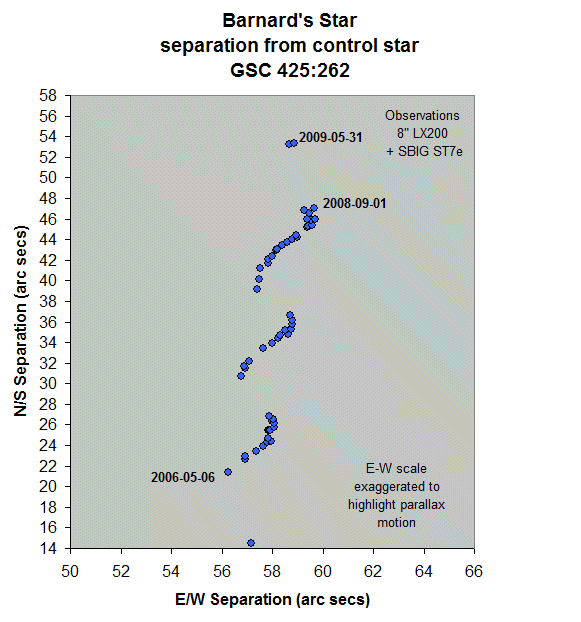 |
| Astrometric solution of Barnard's Star at 2005-09-30 based on 79 UCAC2 starsBarnard's Star Epoch 2000 Position :RA 17h 57m 48.14s, Dec 04d 42m 35.26s |
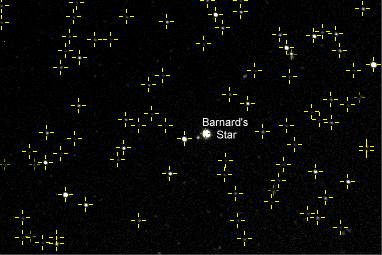 |
| CCD Image 20s exposure, C filter2005-09-30 21:32h UT (#95034) |
Back to Top
Wolf 359 (CN Leo) - 7.8 ly
| **Wolf 359 / CN Leo (Leo)**3rd closest star system to the Sun, 7.8 light years distance |
|---|
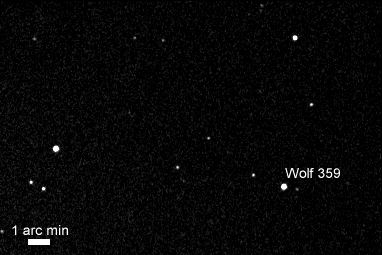 |
| Annotated CCD Image3 x 30 sec exposure (median combine), 2x2 binning, C Filter 2006-12-02 07:03h UT (#156081-83) |
| **Motion of Wolf 359 ( 2006-12-02 + )**[Measured Proper Motion -.- arc sec/year, PA -.- deg (based on -.-- year observation window) ][ cf. xxxxx Value 4.802"/yr, PA 186.9] |
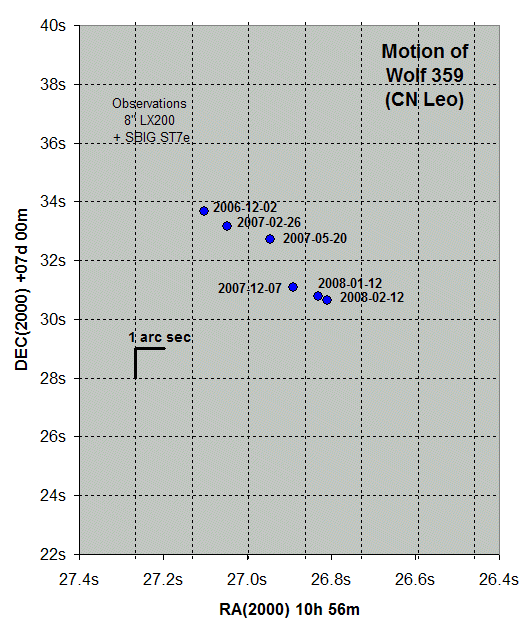 |
Back to Top
Lalande 21185 - 8.3 ly
Lalande 21185 / HIP 54035 lies is Ursa Major at a distance of 8.3 ly.
Back to Top
Ross 248 (HH And) - 10.3 ly
Ross 248 (or HH And) lies around 10.3 light years from the sun. It is a main sequence red dwarf and is variable in brightness.
| Ross 248 (Andromeda)Also known as HH And[ cf. CNS Value : Proper Motion 1.617 "/yr, 177.0 ] |
|---|
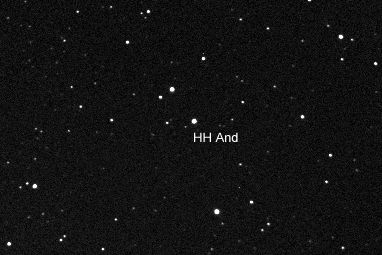 |
| CCD Image 20s exposure, C filter2005-10-05 19:27h UT (#97044) |
| Ross 248 (Andromeda) Reddish tint to Ross 248 is evident in this approximate true colour image |
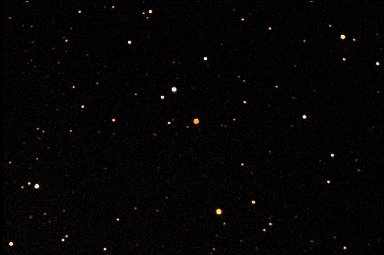 |
| Approximate CCD Image Clear 20s (C Filter), Red 3x 30s (R), Green 3x 30s (V), Blue 3x 60s(B)2005-10-05 19:35h UT (#97044-59) |
| Astrometric solution of Ross 248 at 2005-10-05 based on 65 UCAC2 stars, image scale 1.31 arc sec/pixel |
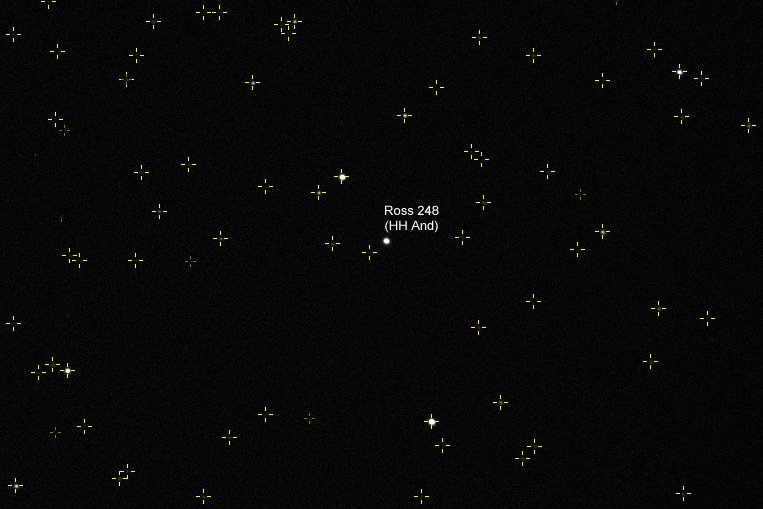 |
| CCD Image 10s exposure, C filter2005-10-05 19:30h UT (#97047) |
| **Motion of Ross 248 ( 2005-10-5 to 2006-07-24 )**[Measured Proper Motion 1.6 arc sec/year, PA 160.0 (based on 0.80 year observation window) ][ cf. Catalog of Nearby Stars (CNS) value 1.617"/yr, 177.0 ] |
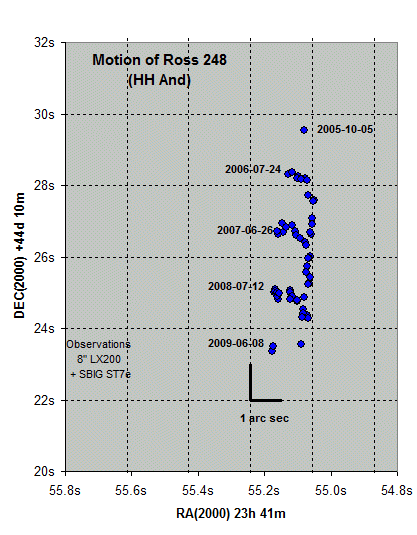 |
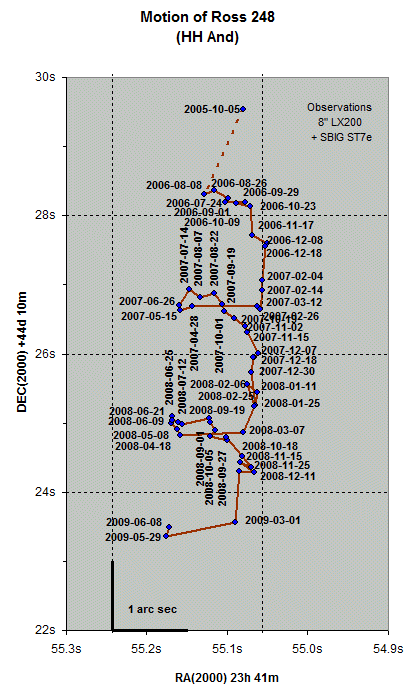 |
Back to Top
61 Cygni - Star (The 'flying star') - 11.4 ly
61 Cygni has a significant proper motion of around 5 arc secs/year, and is the reason behind its nickname - the 'flying star' . Friedrich Wilhelm Bessel studied 61 Cygni and was one of the first astronomers to measure annual parallax.
| **61 Cygni (Cygnus)**comprising the double star pair HIP 104214 & HIP 104217 |
|---|
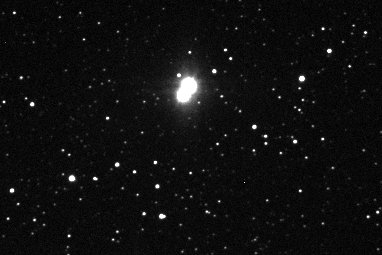 |
| CCD Image 20s exposure, C filter2005-09-30 21:00h UT (#95004) |
| 61 Cygni (Cygnus ) |
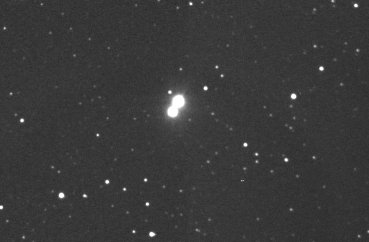 |
| CCD Image (50% size)10 x 5s exposure (average combine), 1x1 binning, C filter2006-05-25 00:09h UT (#127080-93) |
| Motion of 61 Cygni [Measured Proper Motion 5.2 arc sec/year (based on 0.91 year observation window) ] |
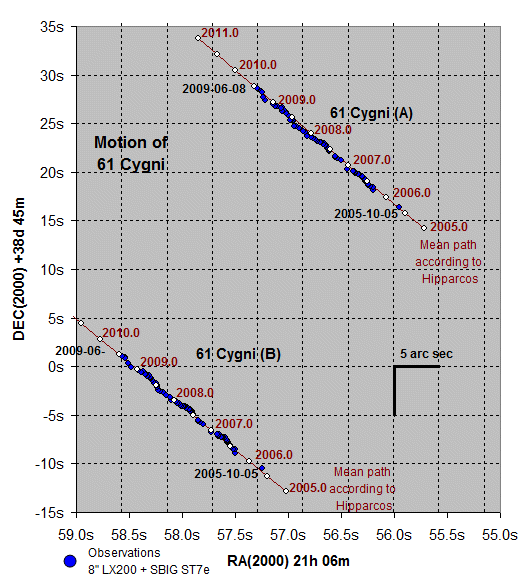 |
| Comparison from of images from 2005-10-5 & 2006-10-25 showing motion of 61 Cygni over 0.63 year interval(White bar is 60 arc secs) |
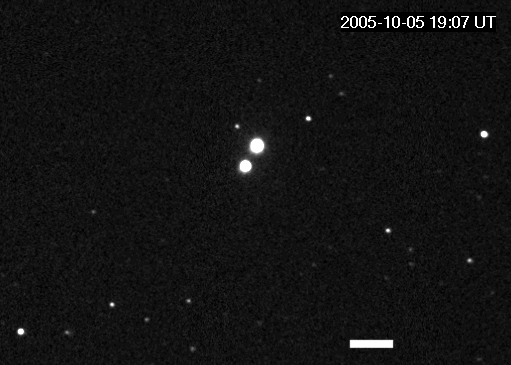 |
| Motion of 61 Cygni A [Measured Proper Motion 5.3 arc sec/year, PA 052.7 (based on 0.89 year observation window) ][ Hipparcos Value 5.281"/yr, 051.9 ] |
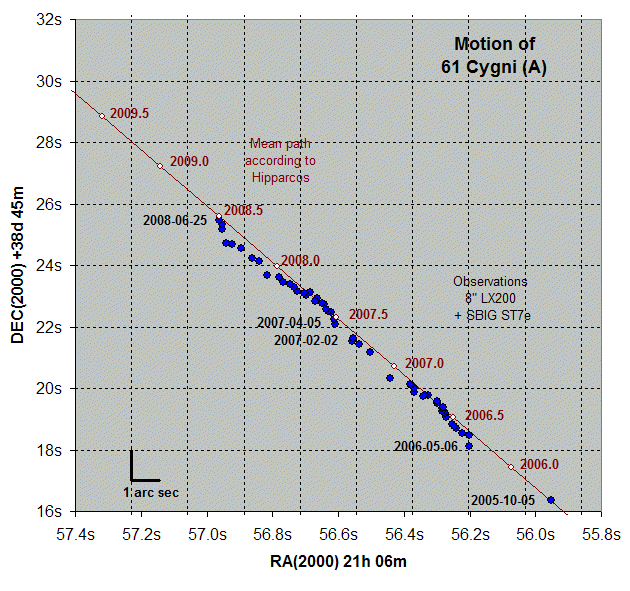 |
| Motion of 61 Cygni B [Measured Proper Motion 5.2 arc sec/year, PA 054.7 (based on 0.91 year observation window) ][ cf . Hipparcos Value 5.172"/yr, 052.6 ] |
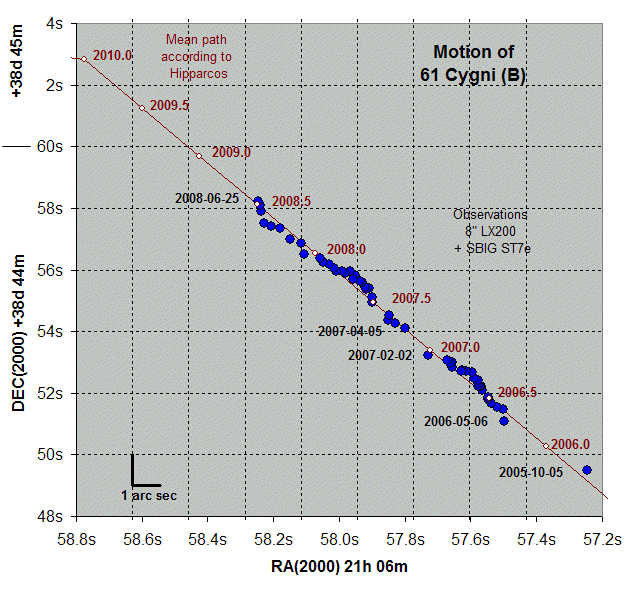 |
| Separation between A-B components |
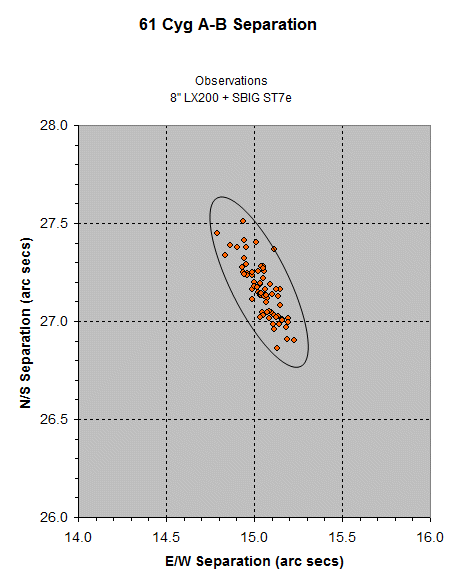 |
| Measurements from 2005 to 2007suggesting gradually widening separation between A-B components at rate of ~ 0.1 arc sec/year |
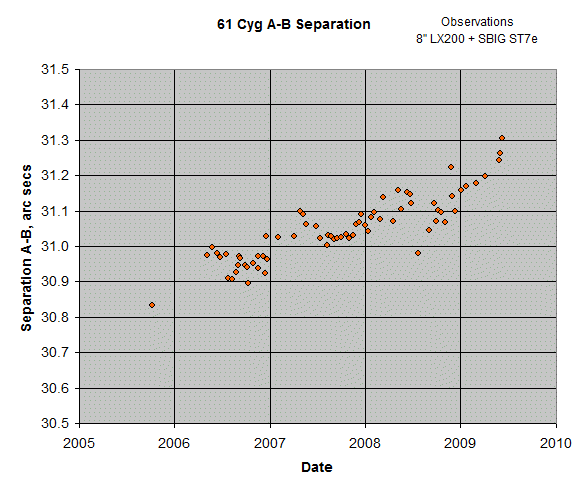 |
Back to Top
Gliese 725 (HIP 91768) - Double Star - 11.5 ly
Red dwarf binary system, located 11.5 light years from the Sun.
| **Gliese 725 (Draco)**a pair of red dwarf stars (Struve 2398) located 11.52 light years away(15th closest star system to the Sun) |
|---|
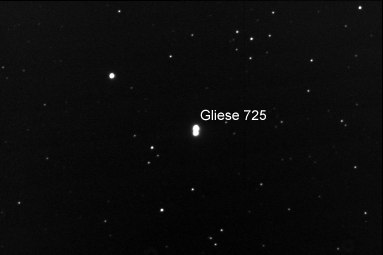 |
| Annoated CCD Image (50% size)7 x 30s exposure (median combine), 1x1 binning, C Filter2007-09-21 21:08 hUT (#215066-72) |
| Gliese 725 - detailshowing A and B componentscatalog separation 13 arc secs, PA 003 degmeasured separation 12.1 arc secs, PA 356 deg, catalog proper motion - A: 2.28 arc sec/year, B: 2.31 arc sec/year |
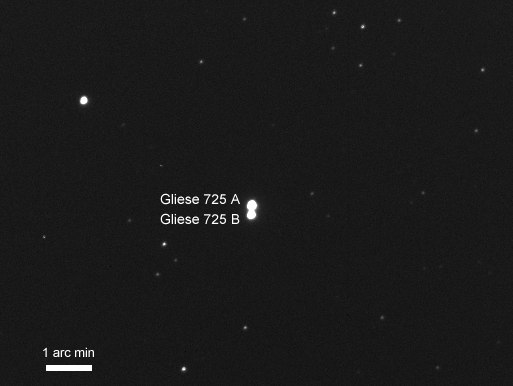 |
| Annotated CCD Image (cropped)30s exposure (median combine), 1x1 binning, C Filter2007-09-21 21:08 hUT (#215069) |
| Motion of Gliese 725 ( 2006-09-21 + ) |
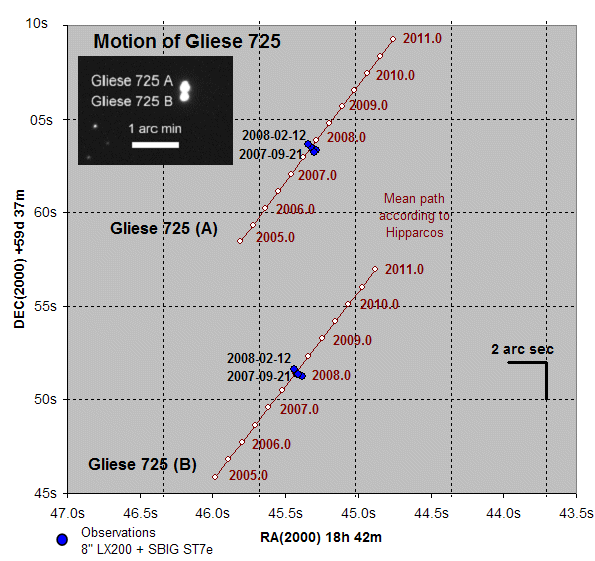 |
| Motion of Gliese 725 A [Measured Proper Motion -.- arc sec/year, PA ---.- (based on -.- year observation window) ][ Hipparcos Value : 2.28 arc sec/year ] |
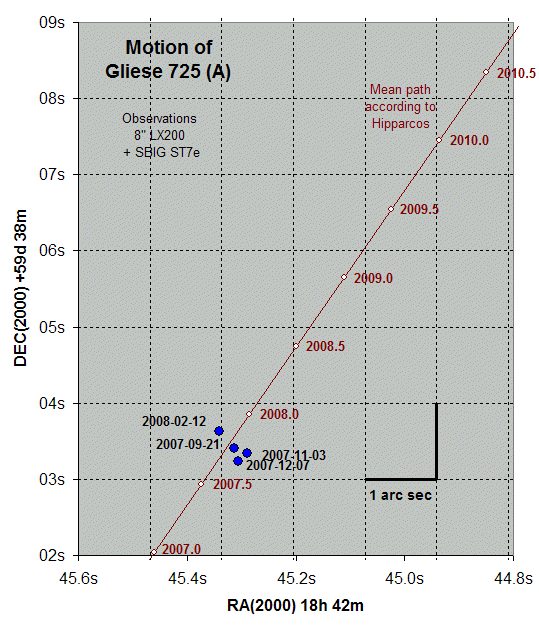 |
| Motion of Gliese 725 B [Measured Proper Motion -.- arc sec/year, PA ---.- (based on -.- year observation window) ][ Hipparcos Value: 2.31 arc sec/year ] |
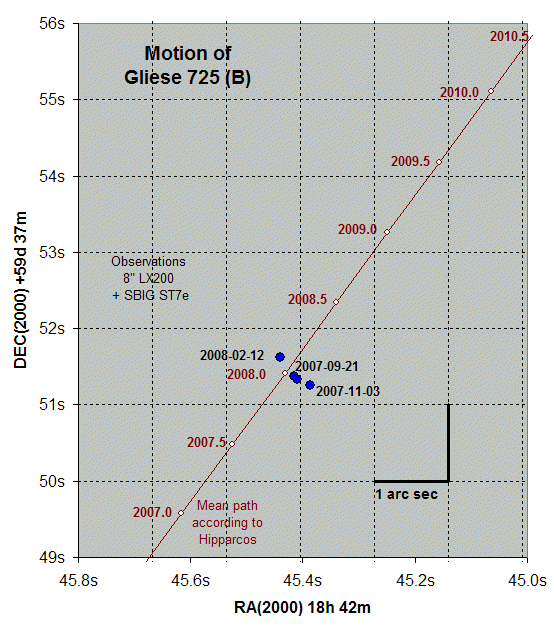 |
Back to Top
Groombridge 34 - Double Star - 11.7 ly
Red dwarf binary system, located 11.7 light years from the Sun. Brightest star is of mag +8.1 with companion star of mag +10.9. Separation measured as 35 arc secs at PA 65 deg. WDS GRB 34 has a proper motion of 2.89 arc secs/year (I hope to record this motion with an image taken in 3-5 years time).
Groombridge 34 AB are both flare stars, like UV Ceti . UV Ceti is an extreme example of a flare star that can boost its brightness by five times in less than a minute, then fall somewhat slower back down to normal luminosity within two or three minutes before flaring suddenly again after several hours.
| WDS GRB 34 (Andromeda)A - GX And, HD 1326B - GQ And[ Hipparcos Proper Motion : 2.918"/yr, 081.9 ] |
|---|
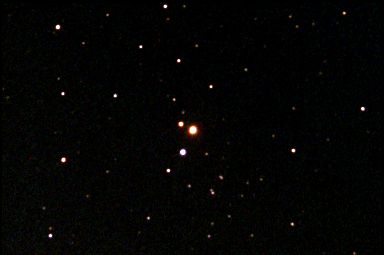 |
| CCD Colour Image Approximate Colour Red 1 min (R filter), Green 1 min (V filter), Blue 1 min (B filter)2005-09-18 20:49h UT (#94008-12) |
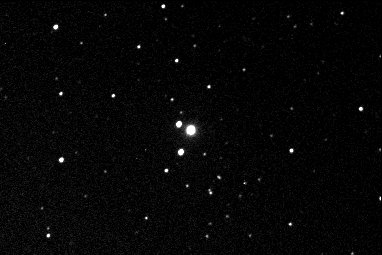 |
| CCD Image20 sec exposure, C Filter 2005-09-18 20:45h UT (#84006) |
| Motion of Groombridge 34 ( 2006 to 2008) |
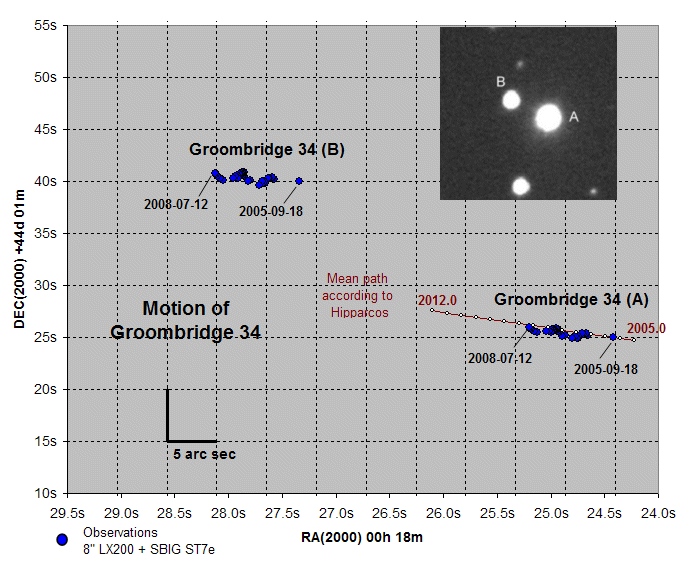 |
| Motion of Groombridge 34 A [Measured Proper Motion -.- arc sec/year, PA ---.- (based on -.- year observation window) ][ Hipparcos Value ] |
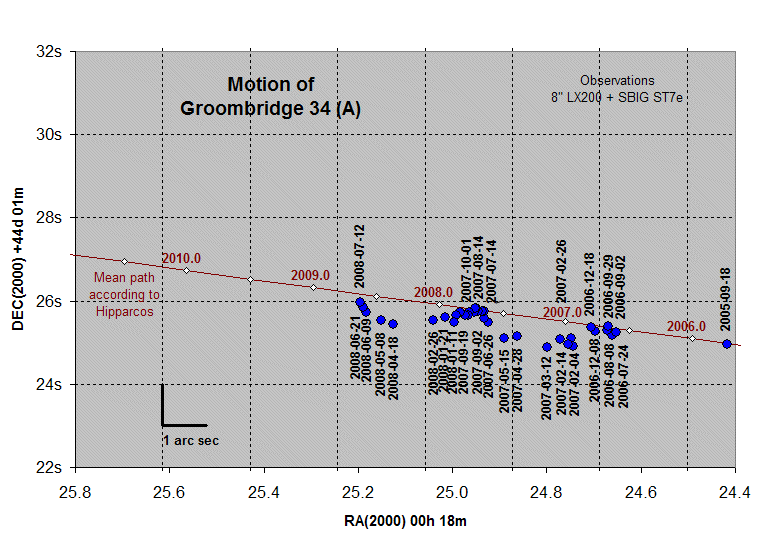 |
| Motion of Groombridge 34 B [Measured Proper Motion -.- arc sec/year, PA ---.- (based on -.- year observation window) ][ Hipparcos Value ] |
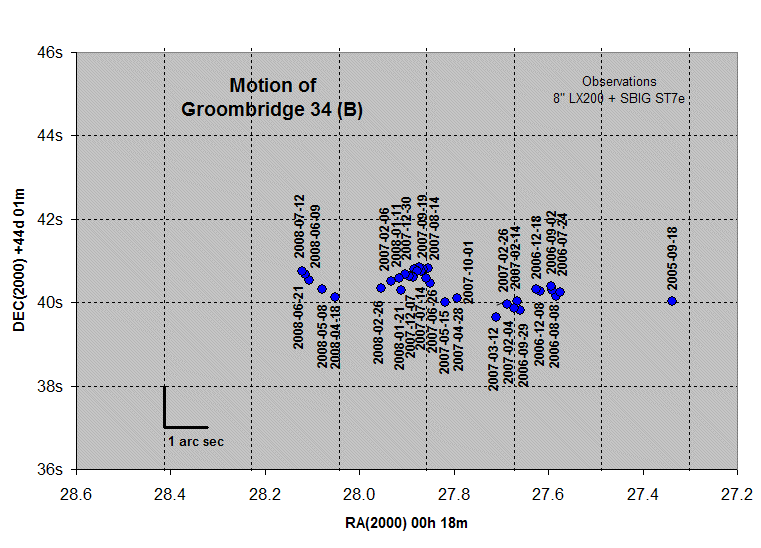 |
Back to Top
Gliese 1111 (DX Cnc) - 11.8 ly
| Gliese 1111 / DX Cnc (Cancer) |
|---|
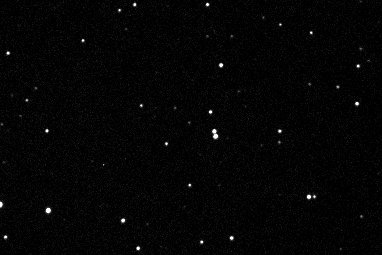 |
| CCD Image 60s exposure, 2x2 binning, C Filter 2006-11-18 03:14h UT (#153274) |
| Motion of Gliese 1111 / DX Cnc |
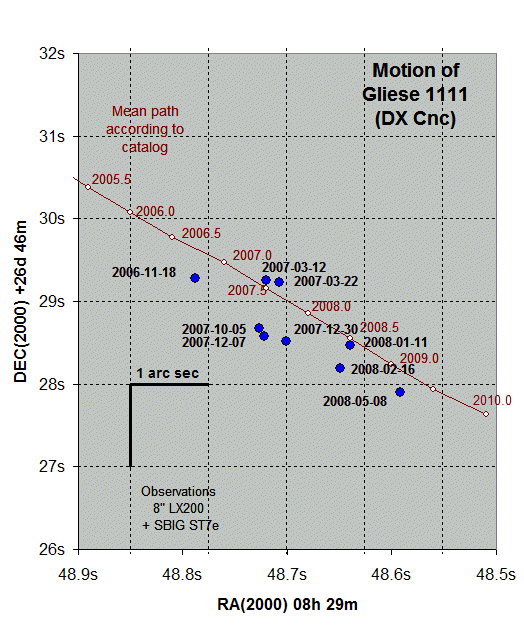 |
Back to Top
HIP 36208 / GJ 273 ("Luyten's Star")- 12.4 ly
"Luyten's Star" is a nearby red dwarf star, lying approximately 12.4 light years from Earth.
| Luyten's Star (Monoceros) |
|---|
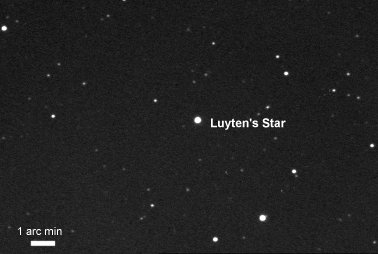 |
| CCD Image (50% scale)7 x 45 sec exposure (average combine), 1x1 binning, C Filter 2009-01-23 22:13h UT (#344101-07) |
| Motion of Luyten's Star[Measured Proper Motion x.x arc sec/year, PA x.x (based on x.x0 year observation window) ][ cf. Catalog of Nearby Stars (CNS) value x"/yr, x.x ] |
Back to Top
SO025300.5+165258 ("Teegarden's Star") - 12.5 ly
"Teegarden's star" (official name SO025300.5+165258) is a nearby red dwarf star, lying approximately 12.5 light years from Earth. It was discovered was announced in 2003 by a team led by Bonnard J. Teegarden. It has a large proper motion (around 5.1 arc secs per year) and a annual parallax motion of approximately 0.26 arc secs (more information on "Teegarden's Star").
[ Reference Proper Motion 5.106"/yr 138.2 (RECONS) ]
| SO025300.5+165258 - "Teegarden's Star" (Aries) |
|---|
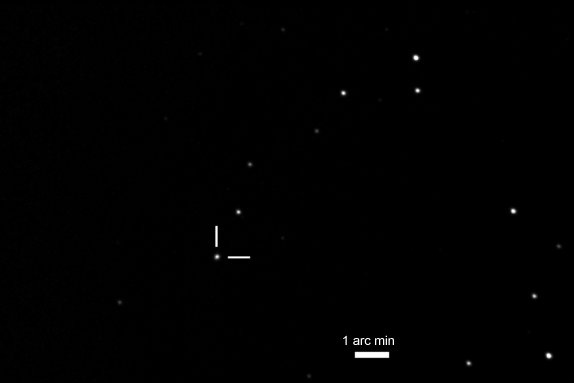 |
| CCD Image (75% scale)6 x 1 min exposure (average combine), 1x1 binning, C Filter 2006-02-02 23:25h UT (#113012-17) |
| Motion of Teegarden's Star[Measured Proper Motion x.x arc sec/year, PA x.x (based on x.x0 year observation window) ][ cf. Catalog of Nearby Stars (CNS) value x"/yr, x.x ] |
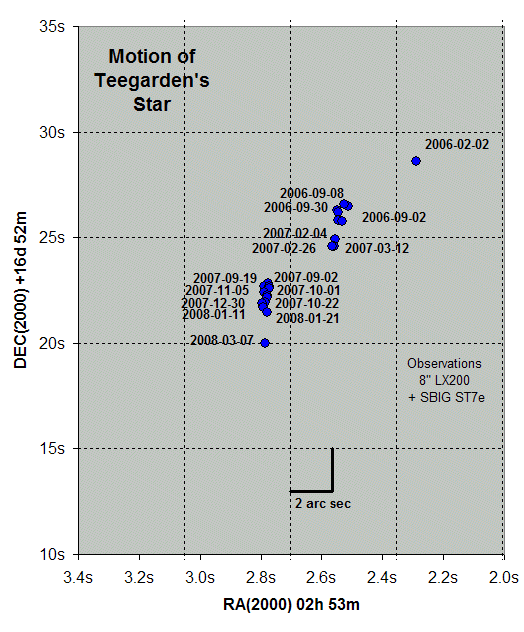 |
Back to Top
HIP 3829 - Van Maanen's Star - 14.1 ly
| **HIP 3829 (Pisces)**Van Maanen's Star(Alt names GJ 35, WD 0046+051, Wolf 28) |
|---|
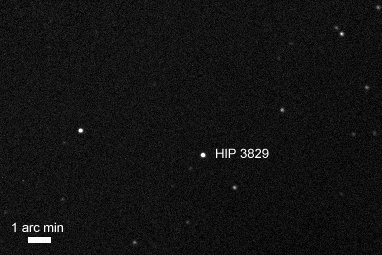 |
| CCD Image 30s exposure, 2x2 binning, C Filter 2006-10-28 23:40h UT (#150218) |
| **Motion of HIP 3829 ( from 2006-10-28 onwards )**[Measured Proper Motion xx arc sec/year, PA xx (based on xx year observation window) ][ cf. Catalog of Nearby Stars (Hipparcos) value 2.978"/yr, 155.5 ] |
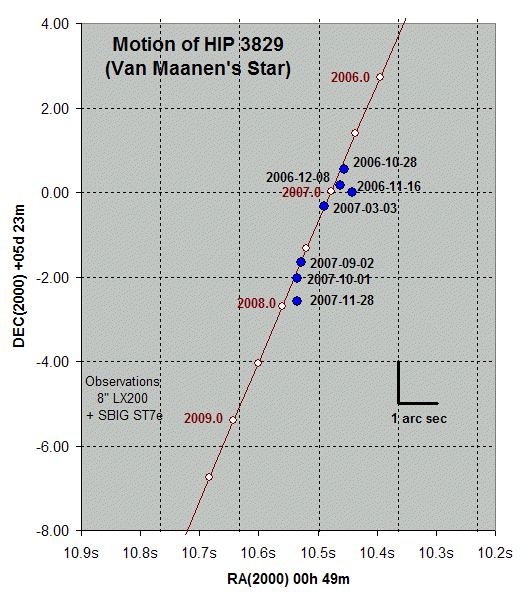 |
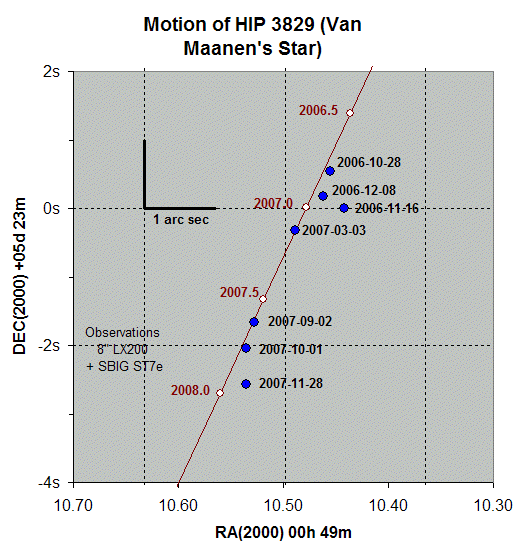 |
Back to Top
Gliese 1245 - star system - 14.8 ly
| Gliese 1245 (Cygnus)(Alt Name V1581 Cyg) |
|---|
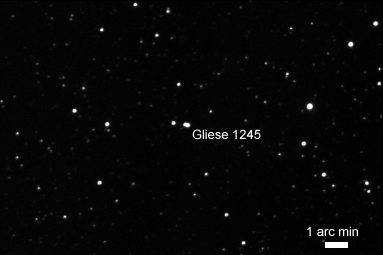 |
| Annotated CCD Image (50% size)7 x 60s (average median combine), 1x1 binning, C filter2006-07-23 23:49h UT (#131146-52) |
| Gliese 1245 - detail A, B, (C : can't be resolved) |
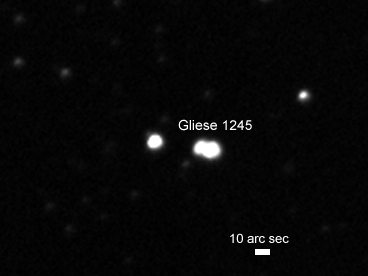 |
| Annotated CCD Image (200% size)Images details as above |
| **Motion of Gliese 1245 ( 2006-07-24 to 2006-08-08 )**[Measured Proper Motion 1 - 2 arc sec/year, PA 303 (based on 0.04 year observation window) ][ cf. Catalog of Nearby Stars (CNS) value 0.731"/yr, 143.1 ] |
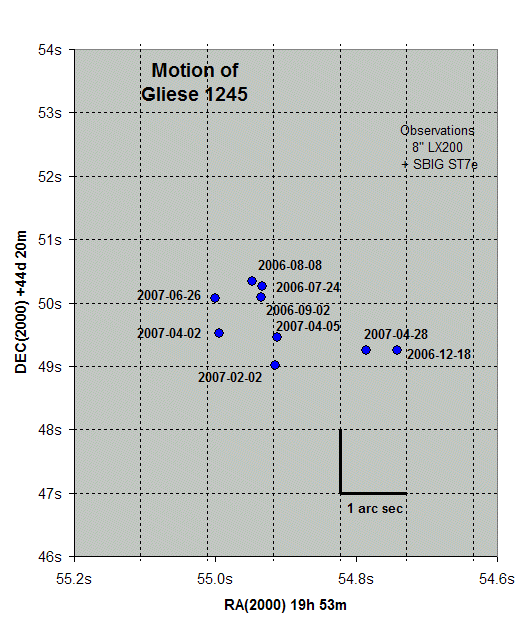 |
Back to Top
Gliese 412, star system - 15.8 ly
| Gliese 412 (Ursa Major)Nearby star system - 15.8 light years from the Sun Binary Star WDS VBS 18 A - HIP 54211B - GCVS WX UMa (1100+44)[ Notes : Measured Separation : 31.3 arc secs, PA 126.3 degThe magnitude for B component (+12.4) appears to be significantly brighter than its catalog range (+14.2 to +16.5) ][ A : Reference Proper Motion 4.511"/yr, 282.1 , Hipparcos][ B : Reference Proper Motion 4.531"/yr, 281.9, CNS ] |
|---|
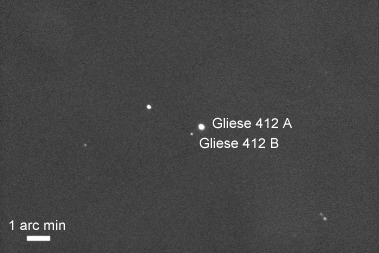 |
| Annotated CCD Image (50% size)7 x 5s exposure (Average median combine), 1x1 binning, C Filter 2006-06-15 00:55 hUT (#128062-68) |
| Motion of Gliese 412 |
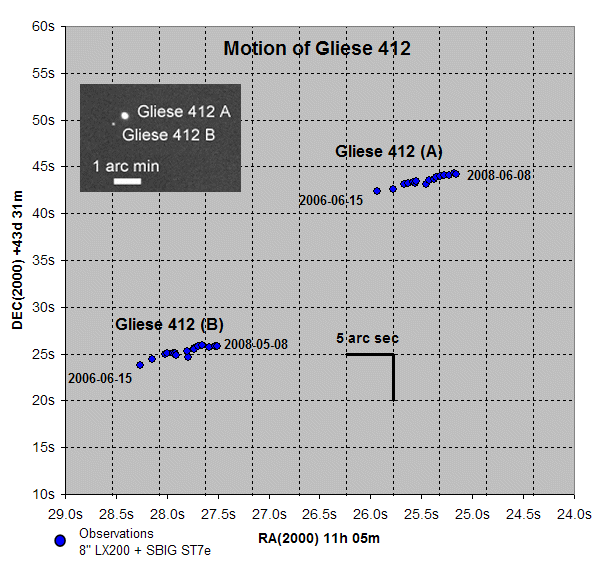 |
| Motion of Gliese 412 A[Measured Proper Motion x arc sec/year, PA x (based on 0.xx year observation window) ][ Hipparcos Value xx"/yr, 0xx ] |
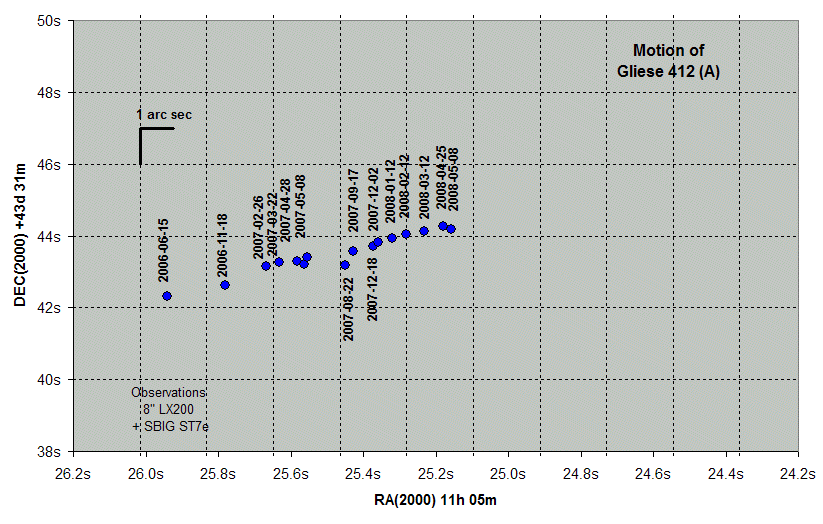 |
| Motion of Gliese 412 B[Measured Proper Motion x arc sec/year, PA x (based on 0.xx year observation window) ][ Hipparcos Value xx"/yr, 0xx ] |
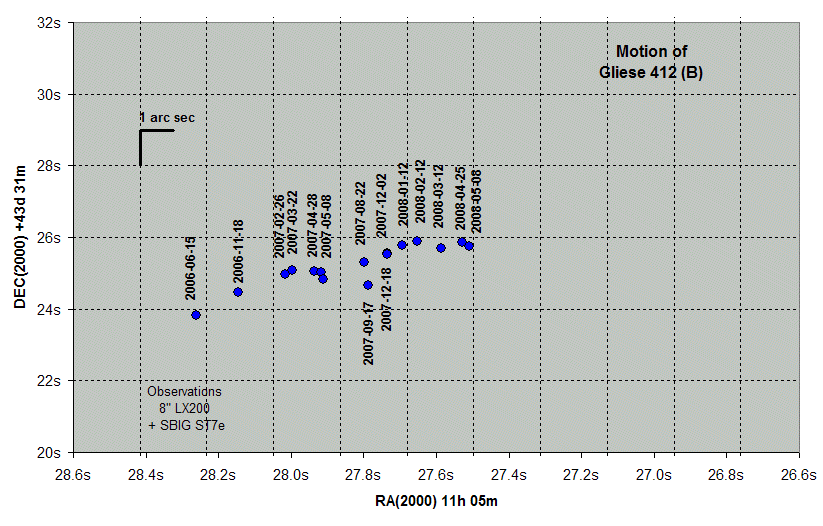 |
Back to Top
Groombridge 1618 - 15.9 ly
Back to Top
EV Lac (GJ 873, HIP 112460) - 16.5 ly
| EV Lac / GJ 873 (Lacerta)(Note : EV Lac is also a UV Cet flare star)Image containing containing 82-85 astrometric reference stars |
|---|
 |
| Annotated CCD Image (75% size)7 x 45 sec exposure (average combine), 1x1 binning, C Filter2008-08-26 00:52 UT (#297206-12) |
| Motion of EV Lac |
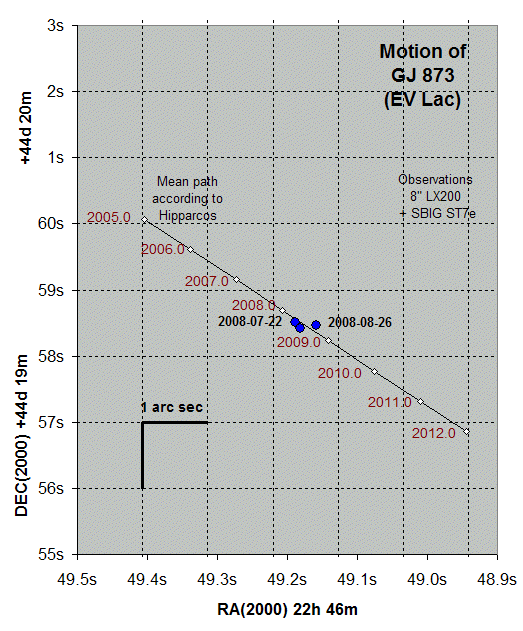 |
Back to Top
Altair - 16.7 ly
| **Altair (Aquila)**16.7 light years from the sun Mag +0.8 |
|---|
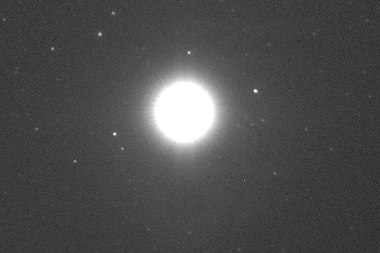 |
| CCD Image, 3 sec exposure, 2x2 binning, C Filter Log brightness scaling (100-1000 ADU)2007-10-01 20:06 h UT (#217001) |
Back to Top
70 Ophiuchi - Double Star - 17 ly
| **70 Ophiuchi (Ophiuchus)**This star is a binary system lying 17 light years from EarthThe system has an orbital period of 88 years, with the pair swinging between 1.6 and 7.0 arc secs[ Astronomy Now magazine, June 2006 ][ Reference Proper Motion 0.19596"/yr, 0.00087, Scholz et al] |
|---|
| Ophiuchi 70 (Ophiuchus) and neighbouring stars Ophiuchi 70 and some of the neighbouirng stars comprise the multiple star Struve 2272The following image shows the Ophiuchi 70 as a bright single object, due to the white-black range used to show the faint neighbouring stars. |
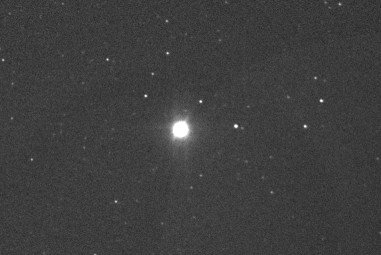 |
| CCD Image (50% size)3 x 5s exposure (average combine), 1x1 binning, C Filter 2006-05-24 23:18 hUT (#127097-99) |
| Ophiuchi 70 (Ophiuchus) - Close up, colour viewThe following image shows the two components as two distinct objects separated by around 5 arc secs and having noticeably different colours.Primary star : Yellowish (catalog mag +4.2), Secondary star : Reddish (catalog mag +5.9)Measured Separation 5.2 +/- 0.5 arc sec, PA : 138 deg +/- 5 degFWHM 4.5 arc secs |
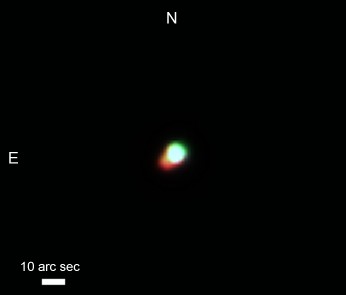 |
| Approximate colour CCD Image (300% size)Red : 3 x 10s exposure (average combine), R Filter Green : 3 x 10s exposure (average combine), V Filter Blue : 3 x 20s exposure (average combine), B Filter 1 x1 binning2006-05-24 23:18 hUT (#127100-108) |
Back to Top
Gliese 752 - 19.9 ly
| Gliese 752 (Aquila)19.85 light years from sun Binary Pair with separation of 74 arc secs (434 AU) Gliese 752aGliese 752b (VB 10), Mag +17VB10 or an Biesbroecks Star is a small very dim red dwarf of 0.08 solar masses. Star t is reported to have a exoplanet that has been detected by astrometry , however this has apparently not yet been definitively confirmed by spectroscopic data.VB10 is a UV Ceti variable (flares)Proper motion is around 1 arc sec/year. |
|---|
| Not yet imaged |
Back to Top
Vega - 25.3 ly
| Vega (Lyra)25.3 light years from sunMag +0.03 star shows significant glare |
|---|
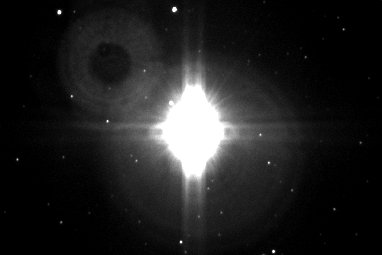 |
| CCD Image 20s exposure, C filter2005-10-02 20:40h UT (#96002) |
Back to Top
Groombridge 1830 - 29.9 ly
| Groombridge 1830 (Ursa Major)Nearby star - 29.9 light years from the SunStar with 3rd largest proper motionAlt Name : HIP 57939 |
|---|
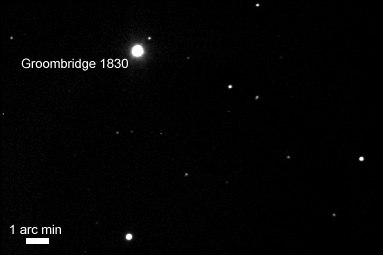 |
| Annotated CCD Image (50% size)7 x 20s exposure (average combine), 1x1 binning, C Filter 2006-11-18 03:37 hUT (#153303-09) |
| **Motion of Groombridge 1830 ( 2006-06-15 to 2006-08-24 )**[Measured Proper Motion 7.1 arc sec/year, PA 154.6 (based on 0.19 year observation window) ] |
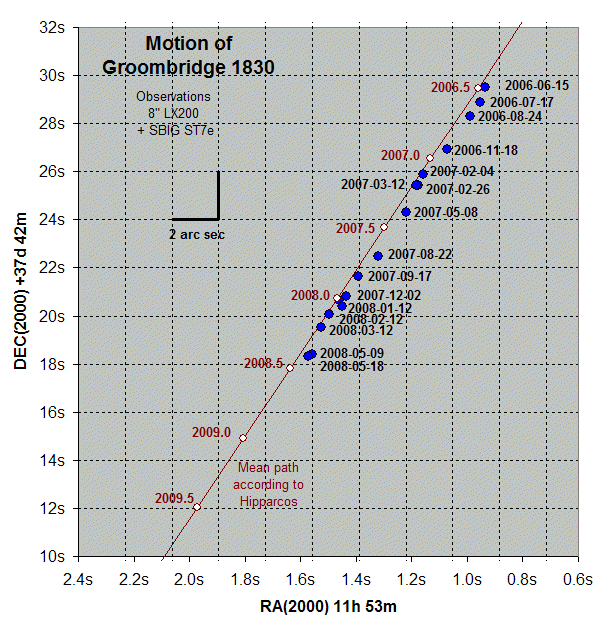 |
Back to Top
HIP 67593 - 43 ly
| HIP 67593 (Bootes) - BD+24 2650BNearby star 43 light years from the SunStar with 6th largest proper motionBinary Star (WD HJ 2688)A : HIP 67594B : HIP 67593[ Notes : Measured Separation : 29.7 arc secs, PA 292.2 deg ] |
|---|
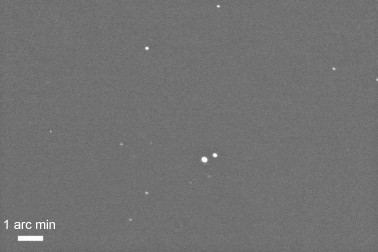 |
| Annotated CCD Image (50% size)5 x 60s exposure (Average median combine), 1x1 binning, C Filter 2006-06-15 01:14 hUT (#128085-89) |
| Motion of HIP 67593 ( 2006-06-15 to 2007-03-04 ) |
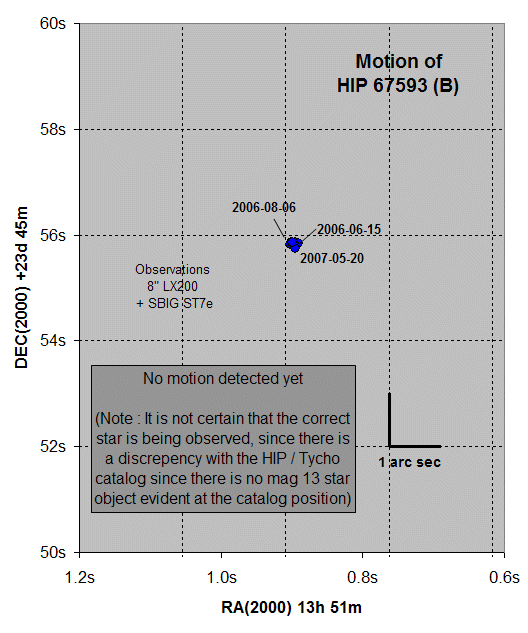 |
| A finder chart for HIP 67593 has recently been found on NStars database http://www.nstars-sci.nau.edu/Main/subpages/charts/1495.00_chart.jpg |
Back to Top
Gamma Draconis - Star
Gamma Draconis was the star that the English physicist Robert Hooke made the first 'modern' attempt to detect annual parallax in 1669. His attempt was unsuccessful, and it was not until the 1830's/1840 that Friedrich Wilhelm Bessel and other astronomers first correctly detected parallax using slightly closer stars (eg 61 Cygni). The star is probably too far away for it to show a parallax that can be measured using amateur equipment. However to check this a baseline astrometric measurement of Gamma Draconis' position was made. This task was made difficult as the number of catalog stars directly around the star is limited. To achieve an adequate plate solution the star was moved to one corner of CCD field of view.
| Astrometric solution of Gamma Draconis (Draco) at 2005-10-13 based on 8 USNOB stars, image scale 1.31 arc sec/pixel |
|---|
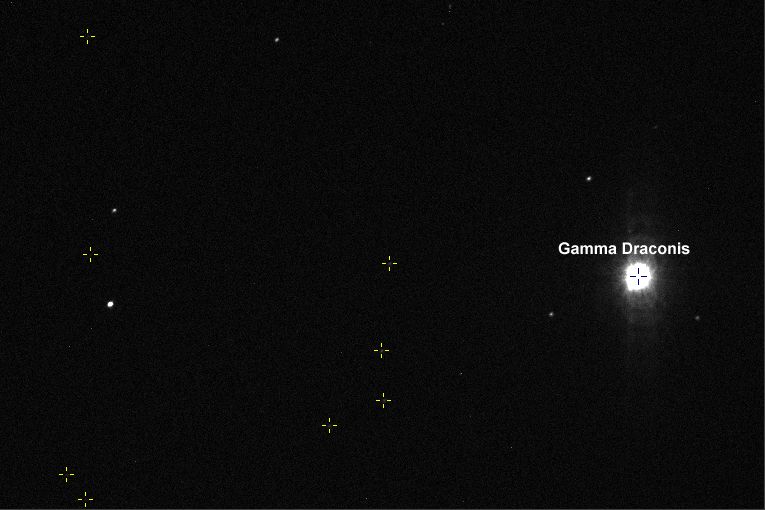 |
| CCD Image 15s exposure, V filter2005-10-13 19:29h UT (#99029) |
Back to Top
Future Project Stars
Potential Future Project Stars
- Luyten's Star / Hip 36208 (CMi) - 12.4 ly
- EV Lac (GJ 873) - 16.5 ly, UV Cet flare star
- Gliese 752 (Aquila) - VB10 mag +17
Web Information on notable nearby stars : http://www.solstation.com/stars.htm
Back to Top
Further Information
Notes ...
Web Information on
Solstation - Notable nearby stars
Top Hundred Nearest Star Systems, RECONS Nasa NStars Database
Back to Top